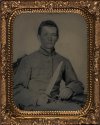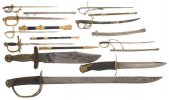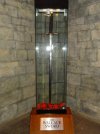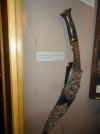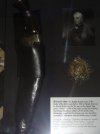- Joined
- Feb 23, 1999
- Messages
- 4,848
The hot days of summer turn my mind to young coconuts, and the refreshing coconut water they contain. Its a taste I acquired in southern India and Sri Lanka in the early 80s. Fortunately there are local markets that fly in fresh coconuts from the regions where they grow.
Red Flower and I bought a box of young coconuts today, and then I faced the difficult decision of which new knife to try out on a coconut. Any knife of the Liberty series is up to the task, but the L1 called out to me, so that is the one I used. It is shorter than the other two, and a bit easier to carry and pack, but it should not be underestimated. The L1 is inspired by the historical Bart Moore bowie. Some think that the Bart Moore knife is the knife Bowie used at the Alamo, but Ill not get into that controversy. Whoever made or used it, it is a masterpiece of design. I Googled it and came up with this page that has a good picture of the Bart Moore bowie and a little of its history. The Bart Moore bowies distinctive forward-curving guard with the ball/hooks at the ends influenced the guards of each of the Liberty series knives.
So on to the coconuts. A necessary preliminary is opening the box.


The coconuts already have much of the husk cut away. A flat cut surface on the bottom enables the coconut to stand still while you open it on the counter. Since the coconut is filled with delicious fluid, one does not want to simply whack it in half. That would cause you to lose much of the precious nectar. Instead, four quick snaps of the wrist will cut a small rectangle out of the top, which can then be pried out. The fluid is then emptied out through this hole.



Once the fluid is out there is still delicious young coconut meat on the inside. Getting at this requires halving the coconut. I usually give one whack across the hole, and then one whack on each side, separating the coconut enough that it can be pulled apart.
The first whack went well.

The second whack split the coconut in half and almost went into the countertop, which I had foolishly not protected.

The penetration was greater than I had expected. Fortunately the countertop was untouched, but my customary third whack was superfluous and was not delivered.

Red Flower and I bought a box of young coconuts today, and then I faced the difficult decision of which new knife to try out on a coconut. Any knife of the Liberty series is up to the task, but the L1 called out to me, so that is the one I used. It is shorter than the other two, and a bit easier to carry and pack, but it should not be underestimated. The L1 is inspired by the historical Bart Moore bowie. Some think that the Bart Moore knife is the knife Bowie used at the Alamo, but Ill not get into that controversy. Whoever made or used it, it is a masterpiece of design. I Googled it and came up with this page that has a good picture of the Bart Moore bowie and a little of its history. The Bart Moore bowies distinctive forward-curving guard with the ball/hooks at the ends influenced the guards of each of the Liberty series knives.
So on to the coconuts. A necessary preliminary is opening the box.


The coconuts already have much of the husk cut away. A flat cut surface on the bottom enables the coconut to stand still while you open it on the counter. Since the coconut is filled with delicious fluid, one does not want to simply whack it in half. That would cause you to lose much of the precious nectar. Instead, four quick snaps of the wrist will cut a small rectangle out of the top, which can then be pried out. The fluid is then emptied out through this hole.



Once the fluid is out there is still delicious young coconut meat on the inside. Getting at this requires halving the coconut. I usually give one whack across the hole, and then one whack on each side, separating the coconut enough that it can be pulled apart.
The first whack went well.

The second whack split the coconut in half and almost went into the countertop, which I had foolishly not protected.

The penetration was greater than I had expected. Fortunately the countertop was untouched, but my customary third whack was superfluous and was not delivered.
















